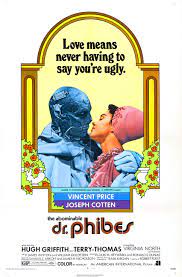
Doctor Anton Phibes (Vincent Price), a famous concert organist, Doctor of Music and of Theology, is supposedly killed in a car-crash in Switzerland in 1921, as he is racing to the hospital where his beloved wife is undergoing emergency surgery. Actually, he survives, but his face is horribly scarred and his voice-box destroyed. He uses prosthetics to somewhat restore his face and an electronic device to provide a voice. But he believes his wife died through the incompetence of her doctors and when he resurfaces in London in 1925, he comes up with a complex plan for revenge.
He is helped by his beautiful, silent, and murderous assistant Vulnavia (Virginia North). He decides to use the ten Plagues of Egypt as inspiration and wears amulets bearing Hebrew letters representing each one. After three of the doctors expire, Scotland Yard Detective Inspector Harry Trout (Peter Jeffries) discovers that all three had worked with Doctor Vesalius (Joseph Cotten) on Victoria’s operation team, with four other doctors and a nurse. Inspector Trout discovers one of Phibes’ amulets at the scene of the fourth doctor’s demise. He takes it to the jeweller who made it, then to a Rabbi to determine its meaning. He comes to the conclusion that Phibes is still alive. Trout and Vesalius go to the Phibes Mausoleum at Highgate Cemetery. They find a box of ashes in his coffin that Trout believes are those of his chauffeur and they find Victoria’s coffin empty.
The police are unable to stop Phibes from killing the rest of the surgical team, so they concentrate on protecting Vesalius himself. Phibes kidnaps Vesalius’ son Lem (Sean Bury) and calls Vesalius to come alone to his mansion on Maldene Square if he wants his son to live. Trout refuses to let him go, so Vesalius knocks him unconscious and races to confront Phibes, who tells Vesalius that his son is under anaesthesia and ready for surgery. There is a key in his body, near his heart, which will unlock his restraints. Vesalius has six minutes to remove it before acid in a container over the boy’s head will be released. Vesalius succeeds and moves the table out of the way. Vulnavia, standing nearby, is surprised by Inspector Trout and steps back. She is drenched with the acid and killed.
Phibes has already left. He believes he has accomplished his mission and retires to the sub-basement to enter a stone sarcophagus containing the body of his wife Victoria (Caroline Munro). He drains his blood and replaces it with embalming fluid, then lies down with Victoria as the stone lid descends.. The police arrive but cannot find Phibes. Just as they realize the final plague is darkness, the lights go out.
The film was directed by Robert Furst, produced by Ronald S. Dunas and Louis M. Heyward, and written by William Goldstein and James Whiton. It is a ready-made cult classic, with Price’s best over-the-top style, impressive Art Deco sets, and dark humour. The plagues are not the same as those in the Old Testament, but they are fiendishly clever. Blood is drained from Doctor Longstreet’s body, Doctor Hargreaves is decapitated by a frog mask, Doctor Dunwoody is attacked by bats, Doctor Kitaj crashes his plane after being swarmed by rats, Doctor Whitcombe is stabbed by a brass unicorn, Doctor Hedgepath is frozen to death by hail from an ice-machine, Nurse Allen is eaten by locusts, Doctor Vesalius almost suffers the death of his firstborn, and Doctor Phibes ends in darkness. As opposed to rivers of blood, frogs, lice, flies, pestilence, boils, hail, locusts, darkness, and the death of the firstborn, in that order.
Peter Cushing was originally cast as Doctor Vesalius but left because of his wife’s illness and Joseph Cotten took over. Critics liked the film in spite of themselves and audiences give it 88% on Rotten Tomatoes. AIP studios didn’t care for it until it became a box-office hit. It was followed by a sequel, Doctor Phibes Rises Again, just as high over the top. The music Phibes plays on the organ is War March of the Priests by Mendelssohn, and Basil Kirchin’s score includes 1920s hits like Charmaine and Darktown Strutter’s Ball. That song was written by Canadian composer Shelton Brooks, who grew up in the same small Ontario town where Vincent Price spent his summers as a child.
Joseph Cotten complained that he had to learn his lines while Vincent Price’s lines would be post-dubbed, but the fact was that Price knew his lines and the lines that everyone else spoke too. He always did. But Price would crack up at his own lines and break his makeup, and he liked to break up Joseph Cotten too. Something called collodion was in Price’s makeup to stop his face from moving. Price and Cotten had worked together in the Thirties with Orson Welles and the Mercury Theatre. Doctor Vesalius was named after a 16th Century Flemish scientist who cut up corpses. The film was slow-paced, deliberate, and mannered, but it was hardly an action feature, despite the earnest presence of Scotland Yard; it was a period feast for the eyes and ears, with sly dark humour—Vincent Price in a parody of a Vincent Price villain.
